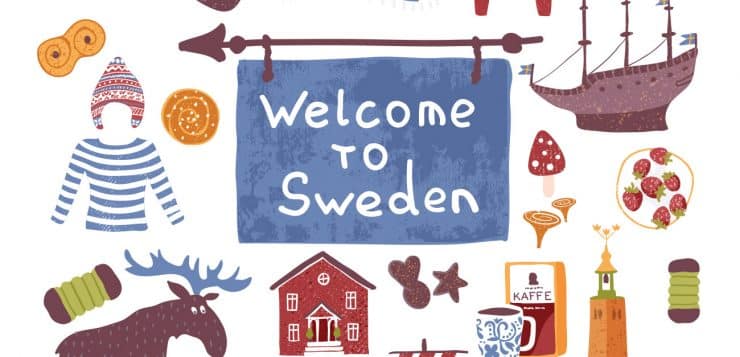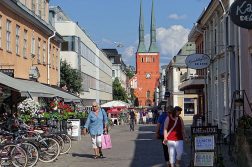The Swedish higher education system is similar to that of other European countries. Here are the basics.
Degree programmes in Sweden
Swedish universities offer degree programmes according to the European standard. This includes bachelor’s, master’s and PhD programmes.
- Bachelor’s programmes, also known as undergraduate programmes, take place after upper secondary school (high school) and are usually three years long (180 ECTS credits).
- Master’s programmes, also known as graduate programmes, build upon the knowledge developed during bachelor’s-level studies and can be one or two years long (60 or 120 ECTS credits).
- PhD programmes, also known as doctoral programmes, are research degrees involving several years of work toward a dissertation. The duration and setup of PhD programmes in Sweden vary between universities; see PhD programmes for more details.
Programmes and courses: what’s the difference?
A degree programme at a Swedish university is made up of a number of courses in a particular field of study leading to a specific degree. Courses, sometimes known as modules in other countries, are the building blocks of each programme. Each semester, programme students follow one large course or several smaller courses.
Instead of applying for a full degree programme, it’s also possible to apply for admission to some courses directly. When you apply for and enrol on a course rather than a programme, you are only registered for that specific course. When you apply for and enrol on a programme, you will then register for many courses over the duration of your programme.
Examples:
- You enrol on a two-year master’s programme made up of four semesters of study. During each semester, you take four courses for 7.5 ECTS credits each, for a total of 120 ECTS credits for the programme.
- You enrol on a one-year master’s programme made up of two semesters of study. During each semester, you take one course for 30 ECTS credits, for a total of 60 ECTS credits for the programme.
- You enrol on a 30-credit course in a subject you’re interested in. You take only that specific course and must turn in a new application if you wish to take additional courses.
- Degree programmes usually contain a mix of compulsory, recommended and optional courses.
Academic calendar
The Swedish academic year is divided into two semesters:
- Autumn semester begins at the end of August and lasts until mid-January, usually with a short break at the end of December.
- Spring semester runs from mid-January to the beginning of June.
Course structure
Full-time studies in Sweden correspond approximately to a 40-hour week, though you may only have a few hours of lectures or seminars each week. The rest of your time is spent reading and working on group projects and other assignments.
You’ll often take only one course at a time for a period of several weeks, after which an examination is given directly. After the examination, a new course begins. For instance, during a 20-week semester, you might take four courses in a row for five weeks each. In some programmes, you might instead take several courses at the same time, with an examination at the end of the semester.
The structure of individual courses varies with the subject area. Technical programmes often include a high proportion of classroom and lab hours, whilst courses in the social sciences may involve fewer classroom hours and more independent and group work.
Lectures and examinations
Courses usually include various types of meetings, including lectures, seminars and laboratory sessions with varying group sizes. Seminar groups can be as small as a few students whilst lectures can be up to a few hundred. The aim is to develop critical thinking and collaborative skills, and students are expected to be active participants in all forms of meetings. Required reading and independent work is usually extensive, regardless of your field of study, and students are expected to come well-prepared to class.
Examinations usually take the form of written or oral tests, laboratory work, group work or special projects. Most programmes conclude with a degree thesis or project.
University or university college?
Two slightly different terms are used in Sweden to describe institutions of higher education: university (universitet) and university college (högskola). The main difference is that universities have the right to award PhD degrees while many university colleges don’t. However, some university colleges do offer PhDs.
There is no difference in the bachelor’s or master’s degrees offered by universities and university colleges, and many university colleges are called ‘university’ in English. As an international student, your experience will be similar regardless of whether you choose to study at a university or university college.
Planning your budget
Planning your budget is an important part of preparing to study in Sweden. Here’s an overview of the different costs you should include in your budget.
In Sweden, the currency used is the Swedish krona (SEK). As at September 1, 2016, conversions are (approximately) as follows:
100 CAD=660 SEK
(see oanda.com or your bank for up-to-date exchange rates)
Application and tuition fees
Application and tuition fees apply to students who are not citizens of an EU/EEA/Nordic country or Switzerland, studying at the bachelor’s or master’s level.
The application fee is SEK 900.
This fee is paid as part of your online application at Universityadmissions.se.
Tuition fees
These range between SEK 80,000 and 140,000 per academic year for most subjects. Programmes in certain fields may have higher fees. The tuition fees for each programme are listed at Universityadmissions.se and on each programme’s website.
Read more about tuition fees and figure out if you’re required to pay fees at Universityadmissions.se.
Living expenses
An average monthly student budget is about SEK 8,000 per month. Of course, your costs will vary depending on where you live and your personal preferences. Read more at Cost of living and on the student blog
blogs.studyinsweden.se/
Student union fees
Students usually join the local student union for a small membership fee. This gives you access to various student activities and student discounts. Fees range from SEK 50-350 per semester, depending on the union. Your relevant student union can provide information on membership fees and benefits.
Textbooks
On average, expect to spend about SEK 750 per month on textbooks. In some subjects, like law and natural sciences, this figure is likely to be higher. Many student unions organise book sales where students can buy used textbooks cheaply; it’s also common for students to post notices on campus selling their used copies of previous years’ textbooks. Websites for buying used textbooks are also popular.
Student life in Sweden
Student life at Swedish universities is as varied as the universities and cities themselves. Whether you’ve chosen to study in an urban centre or a traditional university town, you’ll have a host of activities at your disposal. The hub of student activity is each university’s student union, which organises social events for students. However, you’ll also find many ways to get involved in your local community and in outdoor and sporting events.
Societies and interest groups
Most Swedish universities are home to societies for students sharing a similar interest. Your student union will have listings of societies, and you can also keep an eye out around campus for flyers advertising societies and events.
Nightlife
Many universities offer pubs and clubs on and around campus, and university towns and larger cities offer an array of bars and clubs. The legal age for drinking in Sweden is 18, though some establishments – mainly in the bigger cities – may only admit people over 20 or 23 years of age.
A lot of people go out for a drink on the weekend, and there can be long queues from early on outside the more popular places. Some nightclubs charge an entrance fee, usually ranging from SEK 50 to 150.
City life
It’s no surprise that big cities like Stockholm, Gothenburg, and Malmö offer an active cultural scene, with restaurants to enjoy, concerts to attend, and museums to discover. However, even smaller cities in Sweden have lots to offer off-campus. Discovering all your city and region has to offer and getting involved in your community can be a great way to meet Swedish friends. Ask your university for advice on local events and societies, or visit your local municipality’s website for listings.
Sport and outdoor activities
Students at Swedish universities tend to be very active, and there are many ways to get involved in sport as well as to explore Sweden’s beautiful nature. Most universities offer sport or fitness centres, and many organise intramural teams for sports like football, handball, hockey or bandy. You can also get involved in local community teams through the organisation Korpen or through your municipality‘s listings.
Hiking, cross-country and downhill skiing, and orienteering are popular outdoor sports in Sweden. STF (the Swedish Tourist Association) offers advice on outdoor adventures across the country, and your university may also have advice on local activities.
Contributed by:
Kaisa Tokar, Communications
Embassy of Sweden, Ottawa
www.studyinsweden.se








Discussion1 Comment
Sweden’s tourism allure is a captivating blend of natural beauty, modern innovation, and rich heritage. From the mesmerizing Northern Lights that dance across Arctic skies to the picturesque Stockholm archipelago, Sweden’s landscapes offer an enchanting escape. The country’s progressive cities, exemplified by Stockholm, seamlessly marry historical charm with cutting-edge design, while the indigenous Sami culture of the north adds a unique cultural dimension. With its emphasis on sustainability, outdoor adventures, and a commitment to quality of life, Sweden beckons travelers to explore its pristine wilderness, immerse in local traditions, and witness a harmonious fusion of tradition and innovation.